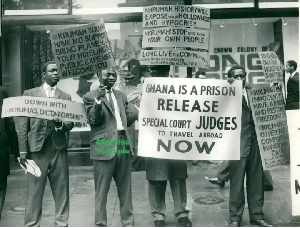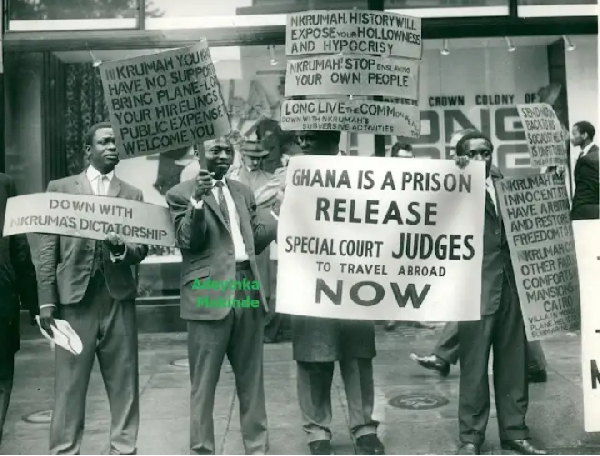 The group gathered outside Marlborough House in London’s Pall Mall
The group gathered outside Marlborough House in London’s Pall Mall
In July 1965, a group of sharply-dressed protesters, many holding placards,gathered outside Marlborough House in London’s Pall Mall during the Commonwealth Prime Ministers Conference.
Their target; Ghana’s then president, Osagyefo Dr Kwame Nkrumah, who was once hailed as a hero of African independence before being accused of betraying democracy.
A black-and-white photograph shared on YouTube by Nigerian lawyer, Adeyinka Makinde captures the tense moment, with the demonstrators, dressed in suits, raising signs that read “Ghana is a Prison” and “Free the Judges.”
What Sparked the Protest?
Barely a year after assuming office, Dr Nkrumah, Ghana’s first post-independence leader, was accused of increasingly centralising power and silencing dissent through the Preventative Detention Act (1958), which allowed imprisonment without trial.
By 1964, Ghana became a one-party state after a heavily controlled referendum. The final straw for many was Nkrumah’s dismissal of Chief Justice Sir Arku Korsah in 1963 after he acquitted three opposition figures in a treason trial.
Judges who resisted political interference were removed, and universities faced censorship.
Exiled opponents, including former ministers, helped organise several protests in London to pressure Commonwealth leaders to isolate Nkrumah.
The Aftermath
Just eight months after that protest, in February 1966, Nkrumah was overthrown in a CIA-backed coup while visiting Vietnam. Ghana’s new military junta cited his autocratic rule as justification.
Though Nkrumah remained a Pan-African icon, his later years were marked by exile and disillusionment. Dr
Nkrumah died on April 27, 1972, in Bucharest, Romania, after a prolonged illness. He was 62 years old. Nkrumah had been in exile in Guinea following his overthrow in 1966.
Meanwhile, catch up on the concluding part of the story of Fort William, where children were sold in exchange for kitchenware, others, below:
ID/AE
